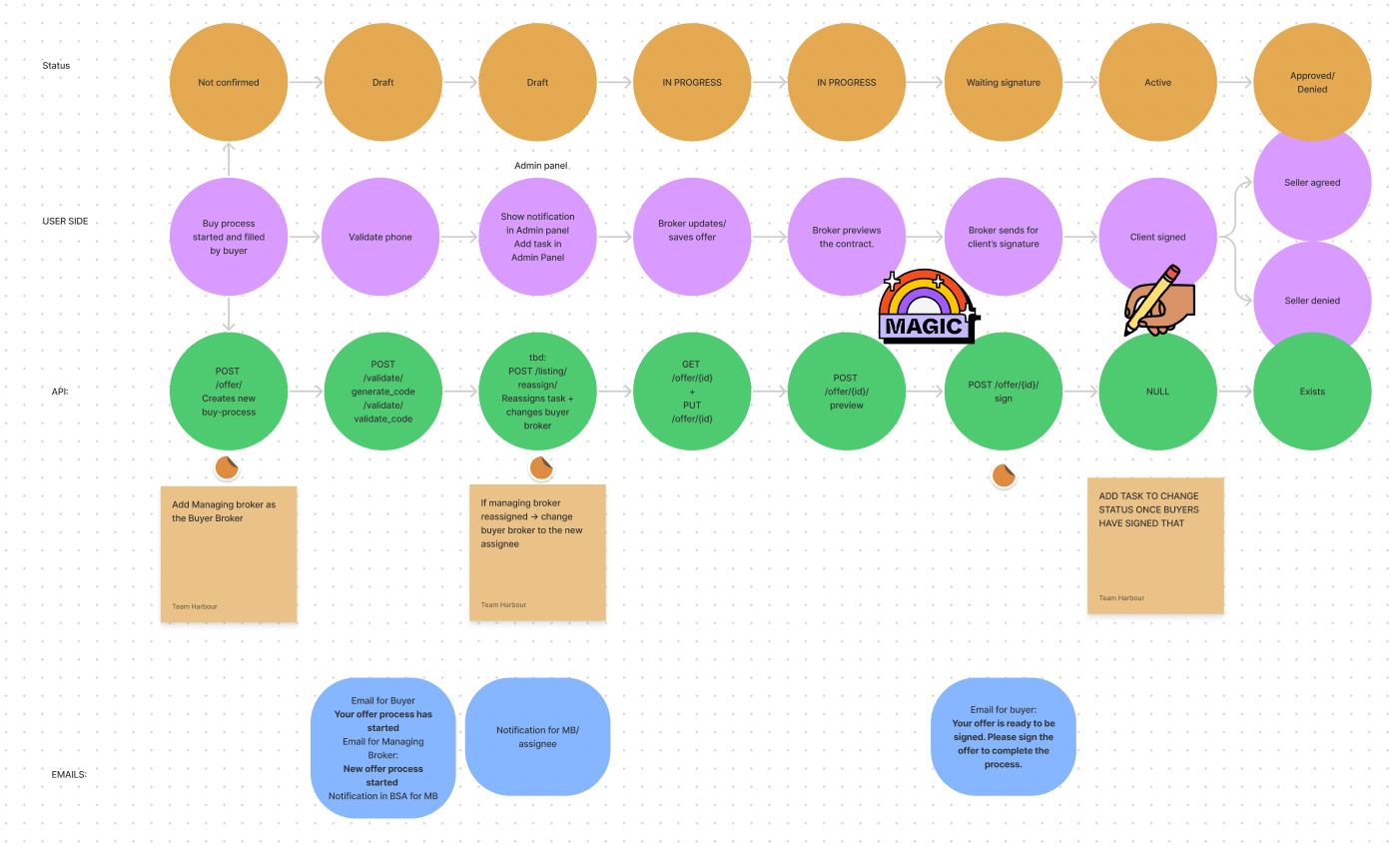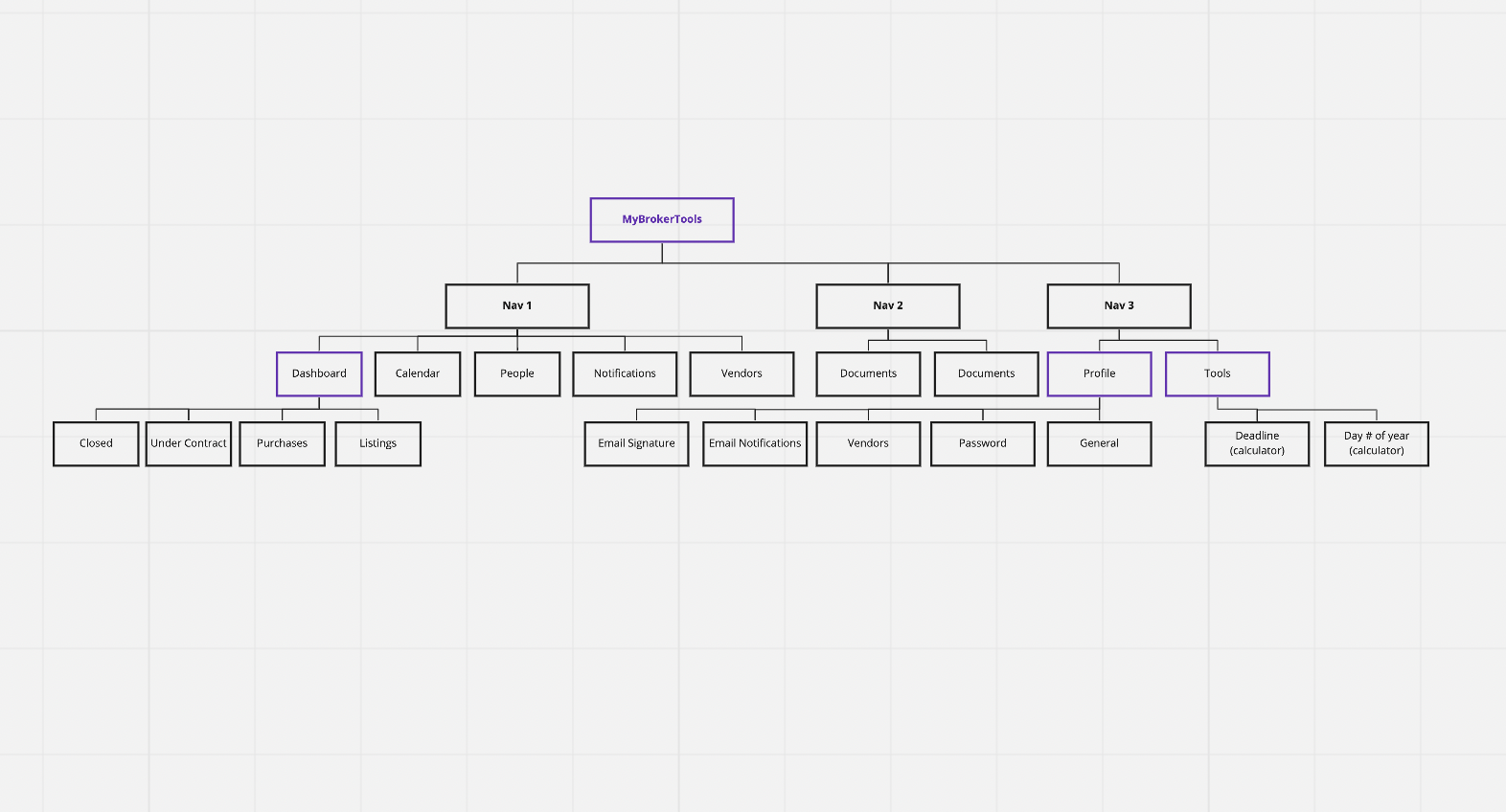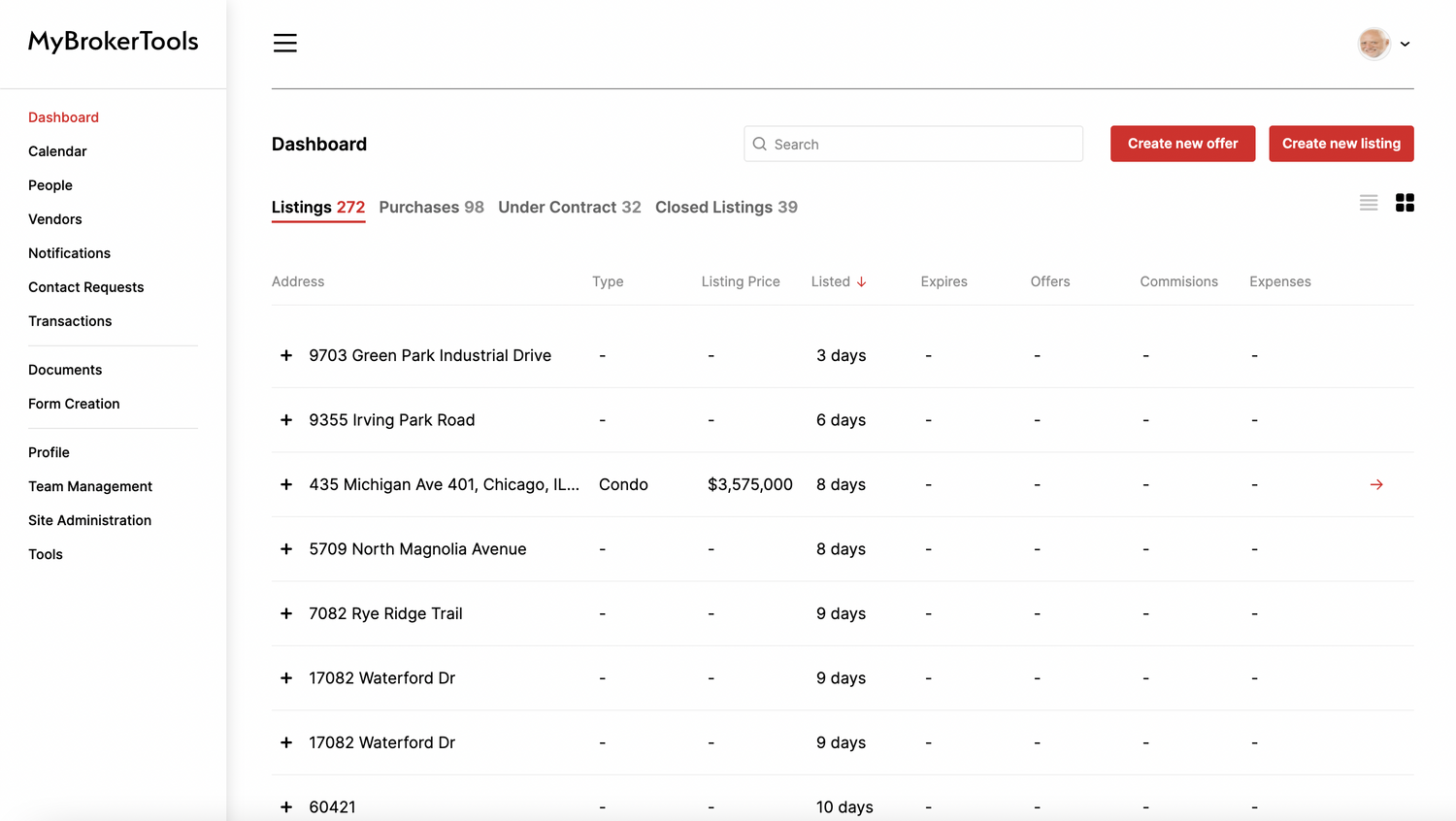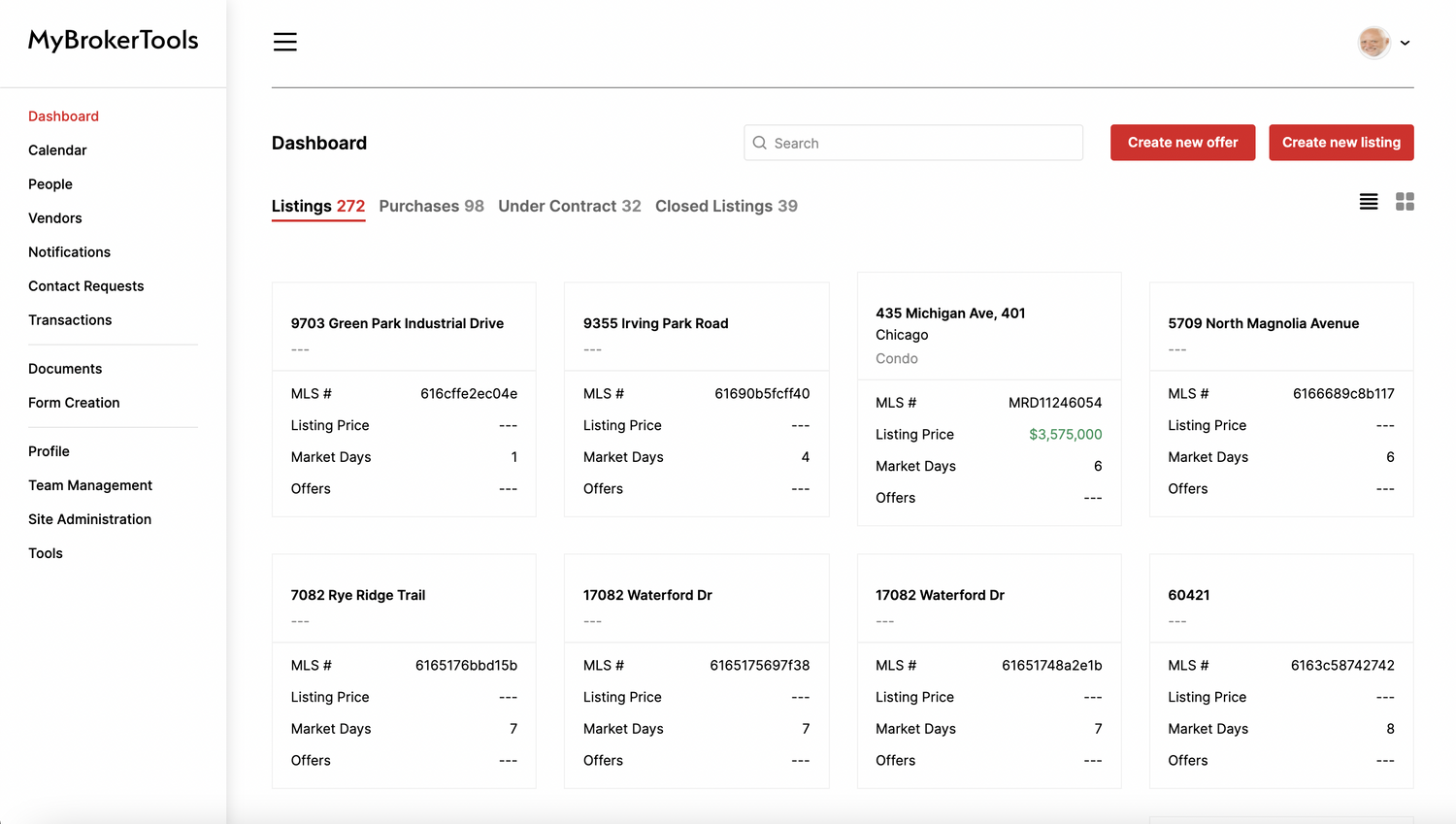MYBROKERTOOLS
MYBROKERTOOLS
Empower agents from
start to finish
Empower agents from
start to finish
MyBrokerTools, as a free-standing software service, extends the reach of XchangePlus by providing basic marketing, automation, and transaction management services for small-to-medium sized real estate brokerages. One of our main objectives for the first iteration of MyBrokerTools (MBT) application was to figure out how agents can spend more time building relationships with clients. We wanted to present all of the content in an engaging way that felt approachable, meaningful and fresh. Our goal is to empower agents from start to finish.
Role — Founding Designer
MyBrokerTools, as a free-standing software service, extends the reach of XchangePlus by providing basic marketing, automation, and transaction management services for small-to-medium sized real estate brokerages. One of our main objectives for the first iteration of MyBrokerTools (MBT) application was to figure out how agents can spend more time building relationships with clients. We wanted to present all of the content in an engaging way that felt approachable, meaningful and fresh. Our goal is to empower agents from start to finish.
Role — Founding Designer
An industry ready to be modernized.
An industry ready to be modernized.
The residential real estate industry at large is outdated, high cost and inefficient. By utilizing multiple software “solutions”, data processing and transaction communication become inefficient and error-prone.
At Xchangeplus, we embarked on an ambitious journey to improve this process by creating an alternative, all-in-one solution for brokerages of any size. MyBrokerTools is positioning itself as the only vendor that can deliver and maintain a complete set of essential business tools and services necessary to run the real estate brokerage business of the future
The Challenge 🧐️
Develop and Implement an MVP in ten months.
The design team’s goal was to reuse and improve already existing modules that are currently utilized in the XP platform to meet the deadline.
Our high level goals were to:
-> Make it accessible. Brokers are always on the go!
-> Give brokers more control over their time and money.
My Role 👋️
I collaborated with one other UX designer. Together we mapped the architecture, designed the entire platform from early wireframes to advanced prototypes, analyzed and conducted user research.
When working on MBT, I communicated with the development team from the outset of every iteration and update. This allowed for clearer insight when designing solutions. During the entire duration, it was important to know what was possible within set timelines while following the product roadmap.
In addition, I worked along side our Product Manager and CEO.
Glimpse of MBT software:
The residential real estate industry at large is outdated, high cost and inefficient. By utilizing multiple software “solutions”, data processing and transaction communication become inefficient and error-prone.
At Xchangeplus, we embarked on an ambitious journey to improve this process by creating an alternative, all-in-one solution for brokerages of any size. MyBrokerTools is positioning itself as the only vendor that can deliver and maintain a complete set of essential business tools and services necessary to run the real estate brokerage business of the future
The Challenge 🧐️
Develop and Implement an MVP in ten months.
The design team’s goal was to reuse and improve already existing modules that are currently utilized in the XP platform to meet the deadline.
Our high level goals were to:
-> Make it accessible. Brokers are always on the go!
-> Give brokers more control over their time and money.
My Role 👋️
I collaborated with one other UX designer. Together we mapped the architecture, designed the entire platform from early wireframes to advanced prototypes, analyzed and conducted user research.
When working on MBT, I communicated with the development team from the outset of every iteration and update. This allowed for clearer insight when designing solutions. During the entire duration, it was important to know what was possible within set timelines while following the product roadmap.
In addition, I worked along side our Product Manager and CEO.





Understand current market solutions and where they are lacking
Understand current market solutions and where they are lacking
What we learned: Current solutions fail to address agent-specific industry needs.
-> Currently operational costs are extremely high for real estate agents. The average agent pays in excess of $10,000 annually in revenue sharing fees to brokerage houses alone. These fees are significantly higher for top producing agents. When factoring in back office support operations, agents can find themselves paying more than $50,000 annually in addition to their revenue sharing obligations;
->Agents generate substantial orderflow by routinely using the services of other professionals such as photographers, inspectors, staging professionals, and digital marketers.
The market is still controlled by the major brokerage houses.
Brokerage Types: traditional, discount, and online brokerages.
What we learned: Current solutions fail to address agent-specific industry needs.
-> Currently operational costs are extremely high for real estate agents. The average agent pays in excess of $10,000 annually in revenue sharing fees to brokerage houses alone. These fees are significantly higher for top producing agents. When factoring in back office support operations, agents can find themselves paying more than $50,000 annually in addition to their revenue sharing obligations;
->Agents generate substantial orderflow by routinely using the services of other professionals such as photographers, inspectors, staging professionals, and digital marketers.
The market is still controlled by the major brokerage houses.
Brokerage Types: traditional, discount, and online brokerages.
Traditional
Agents make up to 6% commission on a sale paying 20-50% through to the brokerage
Discount/ Flat fee
Agents receive a discounted or flat commission and pay a flat fee on every transaction they close
Online
Buyers/ Sellers pay a flat fee, agents are paid a salary
Addressing User Specific Needs:
Buyers/Sellers, Traditional Brokers, Innovative Brokers (Discount and Online):
Addressing User Specific Needs:
Buyers/Sellers, Traditional Brokers, Innovative Brokers (Discount and Online):
Buyers / Sellers
Avg. 6% Broker Commission
Avg. 2.5% Third-party Vendor Fees
Up to 3.5% Mortgage Costs
arrow-down
arrow-down
arrow-down
MBT's automation process will allow brokers to cut their commission and charge a more reasonable fee compared to services offered while being more competitive.
Traditional Brokers
25-50% Brokerage Fee
Desk Fees, Office Fees
Professional Fees
MLS Fees / Marketing Costs
arrow-down
arrow-down
arrow-down
MBT’s software tools will allow individual or partnership brokers aligned with traditional big-box firms to become independent and keep more of their profits.
Innovative Brokers
Software Costs
Office & Admin Costs
Professional Fees
MLS Fees / Marketing Fees
arrow-down
arrow-down
arrow-down
MBT's automation & software cost-effectiveness will allow more innovative brokers to switch to flat-fee or discount services and completely turn around the market.


The Broker
The Broker
Whilst evaluating the competitor landscape, we were able to define project milestones and begin research into user needs, constraints, and pain‐points. Our research revealed that every users' motivations for selling and buying real estate differ, however unitarily the end goal is the same- to close deals. For the first iteration of the software, we focused on supporting the goals of Jennifer and Mark, our primary personas. We used personas constantly throughout the project to guide priorities, and design decisions.
As design lead, I prioritized research early on to have a clearer understanding of the business, users, technology, market, investor demands, etc. This help create empathy amongst the client and teams.
Whilst evaluating the competitor landscape, we were able to define project milestones and begin research into user needs, constraints, and pain‐points. Our research revealed that every users' motivations for selling and buying real estate differ, however unitarily the end goal is the same- to close deals. For the first iteration of the software, we focused on supporting the goals of Jennifer and Mark, our primary personas. We used personas constantly throughout the project to guide priorities, and design decisions.
As design lead, I prioritized research early on to have a clearer understanding of the business, users, technology, market, investor demands, etc. This help create empathy amongst the client and teams.



Extracting Requirements
Extracting Requirements
When designing the MBT (Mybrokertools) software, we needed to incorporate two components;
-> give brokers the ability to have their own semi-custom, high quality website in line with the standards of existing market leaders
-> offer brokers a variety of online tools to manage their teams, leads, website, and daily operations

The user flow begins with two processes: The Buy and the Sell.
Understanding the Buy and Sell process helped us map out our product requirements.

MBT needs to include
-> Content and website management tools
-> Team Management and HR tools -Developed for XP
-> Three-tier user management system -Developed for XP
-> MLS integration
-> E-signature tool(s) -Developed for XP
-> Form creation and contract building tools -Developed for XP
-> Custom calendar -Developed for XP
-> Basic social medial marketing application
-> Email system -Developed for XP
-> Document storage/management system -Developed for XP
-> Direct integration with the XchangePlus transaction management system
This decision was driven by empirical findings on user preferences, goals, and behaviours based on brokers using Xchangeplus. We used XchangePlus analytics (from key brokerage accounts) and consumer research to see what design features performed well amongst XP users.

When designing the MBT (Mybrokertools) software, we needed to incorporate two components;
-> give brokers the ability to have their own semi-custom, high quality website in line with the standards of existing market leaders
-> offer brokers a variety of online tools to manage their teams, leads, website, and daily operations

The user flow begins with two processes: The Buy and the Sell.
Understanding the Buy and Sell process helped us map out our product requirements.

MBT needs to include
-> Content and website management tools
-> Team Management and HR tools -Developed for XP
-> Three-tier user management system -Developed for XP
-> MLS integration
-> E-signature tool(s) -Developed for XP
-> Form creation and contract building tools -Developed for XP
-> Custom calendar -Developed for XP
-> Basic social medial marketing application
-> Email system -Developed for XP
-> Document storage/management system -Developed for XP
-> Direct integration with the XchangePlus transaction management system
This decision was driven by empirical findings on user preferences, goals, and behaviours based on brokers using Xchangeplus. We used XchangePlus analytics (from key brokerage accounts) and consumer research to see what design features performed well amongst XP users.




For V1, our beta users are initially XP users. Together, the PM and I categorized and jotted a broad set of tasks that alligned with our existing content and features. We visualized what existing functionality would be useful in supporting these tasks, and then evaluated which features needed to be innovated or discarded from the MBT software.



The framework
The framework
Our goal at Xchangeplus was to rapidly improve the velocity with which the dev team build, in addition to creating a shared design language around software for future teams to leverage. Luckily, we got the chance to test this with MyBrokerTools. We used our previously designed elements for XP in MBT. With MBT, our vision was to evolve the design language, and introduce interactions that would enhance the experience of using our softwares. As we worked on the MBT UI, I encouraged the design team to think of creative ways we could mimick interactions between both applications.
Example: Xchangeplus’s form creation tool
For MBT we added microinteractions with the templates and folder names.









MBT is a mobile first platform. We wanted users to efficiently use MBT on their mobile devices.
Form Creation tool on mobile device shown below.

MVP Visual Design Delivery:
Entry Point A: Dashboard (List View)

Entry Point A: Dashboard (Card View)

MBT is a mobile first platform. We wanted users to efficiently use MBT on their mobile devices.
Form Creation tool on mobile device shown below.

MVP Visual Design Delivery:
Entry Point A: Dashboard (List View)

Entry Point A: Dashboard (Card View)

MBT is a mobile first platform. We wanted users to efficiently use MBT on their mobile devices.
Form Creation tool on mobile device shown below.

MVP Visual Design Delivery:
Entry Point A: Dashboard (List View)

Entry Point A: Dashboard (Card View)

MBT is a mobile first platform. We wanted users to efficiently use MBT on their mobile devices.
Form Creation tool on mobile device shown below.

MVP Visual Design Delivery:
Entry Point A: Dashboard (List View)

Entry Point A: Dashboard (Card View)


